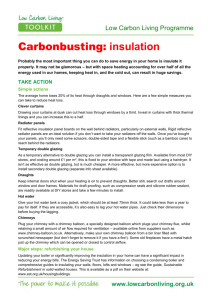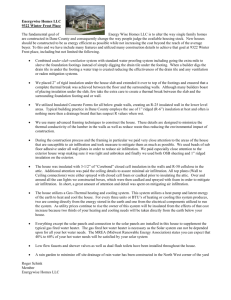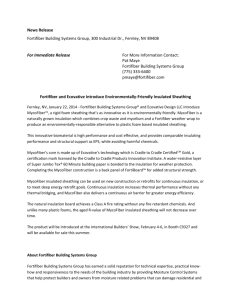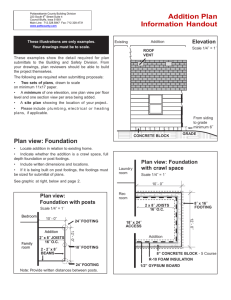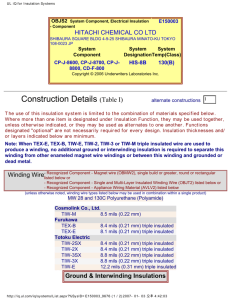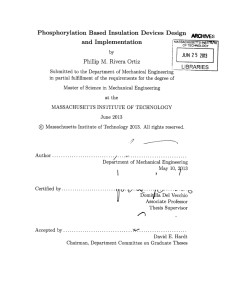Practical solutions for a warmer home
advertisement
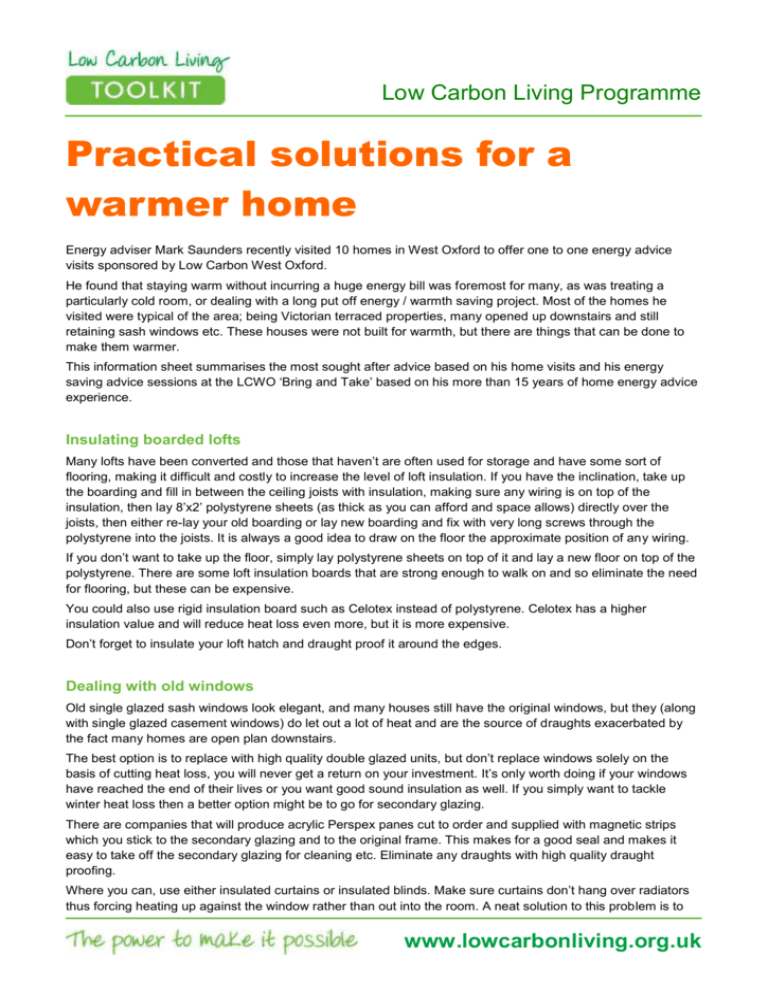
Low Carbon Living Programme Practical solutions for a warmer home Energy adviser Mark Saunders recently visited 10 homes in West Oxford to offer one to one energy advice visits sponsored by Low Carbon West Oxford. He found that staying warm without incurring a huge energy bill was foremost for many, as was treating a particularly cold room, or dealing with a long put off energy / warmth saving project. Most of the homes he visited were typical of the area; being Victorian terraced properties, many opened up downstairs and still retaining sash windows etc. These houses were not built for warmth, but there are things that can be done to make them warmer. This information sheet summarises the most sought after advice based on his home visits and his energy saving advice sessions at the LCWO ‘Bring and Take’ based on his more than 15 years of home energy advice experience. Insulating boarded lofts Many lofts have been converted and those that haven’t are often used for storage and have some sort of flooring, making it difficult and costly to increase the level of loft insulation. If you have the inclination, take up the boarding and fill in between the ceiling joists with insulation, making sure any wiring is on top of the insulation, then lay 8’x2’ polystyrene sheets (as thick as you can afford and space allows) directly over the joists, then either re-lay your old boarding or lay new boarding and fix with very long screws through the polystyrene into the joists. It is always a good idea to draw on the floor the approximate position of any wiring. If you don’t want to take up the floor, simply lay polystyrene sheets on top of it and lay a new floor on top of the polystyrene. There are some loft insulation boards that are strong enough to walk on and so eliminate the need for flooring, but these can be expensive. You could also use rigid insulation board such as Celotex instead of polystyrene. Celotex has a higher insulation value and will reduce heat loss even more, but it is more expensive. Don’t forget to insulate your loft hatch and draught proof it around the edges. Dealing with old windows Old single glazed sash windows look elegant, and many houses still have the original windows, but they (along with single glazed casement windows) do let out a lot of heat and are the source of draughts exacerbated by the fact many homes are open plan downstairs. The best option is to replace with high quality double glazed units, but don’t replace windows solely on the basis of cutting heat loss, you will never get a return on your investment. It’s only worth doing if your windows have reached the end of their lives or you want good sound insulation as well. If you simply want to tackle winter heat loss then a better option might be to go for secondary glazing. There are companies that will produce acrylic Perspex panes cut to order and supplied with magnetic strips which you stick to the secondary glazing and to the original frame. This makes for a good seal and makes it easy to take off the secondary glazing for cleaning etc. Eliminate any draughts with high quality draught proofing. Where you can, use either insulated curtains or insulated blinds. Make sure curtains don’t hang over radiators thus forcing heating up against the window rather than out into the room. A neat solution to this problem is to www.lowcarbonliving.org.uk have a radiator shelf just above the radiator with the curtains finishing just above the shelf. The shelf will help push heat out into the room. Treating a cold wall Most homes in the area are of solid wall construction and will undoubtedly be losing a good proportion of their heat through these walls. External insulation will only be an option if you propose to treat the whole house, which will be expensive and probably out the question in the conservation area. In most terraced houses the amount of wall to be treated is relatively small and might be more easily dealt with from the inside, either with insulated plasterboard for dry lining (only for the really competent DIYer) or applying an insulated wall covering such as Sempatap ( they also do a version for floors called Sempafloor). You will lose some space; up to 10cm with dry lining and 1cm with Sempatap and you will need to remove radiators, cupboards, shelves, switches, sockets and skirting boards to get back to a clean surface. These can all be put back again once the work has been done. Rooms at the front and rear on the first floor with external walls, and old loft conversions and rear extensions can all be dealt with in this way. If you can afford the cost and the extra loss of space go for dry lining with at least 45mm thick insulated plaster board. If you’re on a tight budget use Sempatap, it’s relatively cheap and easy to apply. You will need to order it from http://www.mgcltd.co.uk/ Treating a cold ground floor Most properties in West Oxford have uninsulated suspended timber floors, which can be very cold. If you have a trap door to access the underfloor space, it is possible to insulate under the floorboards between the joists with either Rockwool or rigid insulation board such as Celotex (taking care not to restrict ventilation to the underfloor space). If you do not have easy access to get underneath the floorboards, it would involve ripping the floor up and replacing it in order to insulate under the floor, which is disruptive and quite expensive. I’m afraid if you want bare boards and cannot insulate, you will have to accept a cold floor, but do your best to plug any gaps between the boards and at the skirting boards in order to cut out the worst of the draughts. The easiest option is to cover your floor with some form of insulating material, better still if it also acts as a vapour barrier such as the foil backed insulated mats used in conjunction with insulating before installing laminate flooring. You can always use this even if you are not installing a laminate or engineered wood floor. If you’re installing carpet, using an insulating carpet underlay will also help. Cork is an excellent natural insulator and can also look good as a finished surface. Cork tiles are widely available and relatively inexpensive. Draughts (front doors and entrance hall) Many of the properties I visited had a small entrance lobby leading straight into the main sitting room and also to the stairs. This means any heat generated downstairs will go upstairs and in so doing create a draught, pulling in air through ill fitting doors and windows as it goes. A simple solution would be to fit a curtain or better still a door to stop heat from the sitting room going upstairs. This should also reduce the impact of any draughts, but it is still worth draught proofing your front door and fitting a curtain over the front door to add an extra level of draught protection. This work is part of the Low Carbon Living Toolkit and is licensed under a Creative Commons AttributiononCommercial-ShareAlike 3.0 Unported License. If you have any questions or tips to suggest please email them to us at lowcarbon@hotmail.co.uk v1 27/01/14 Whilst we have made every attempt to ensure the accuracy of this leaflet, this information should not be relied upon as a substitute for formal advice. LCWO will not be responsible for any loss, however arising, from the use of, or reliance on this information. Low Carbon West Oxford is a registered charity 1135225. www.lowcarbonliving.org.uk Hot water If you have a hot water tank that is heated via your boiler or its own immersion coil, it does not have to be heated 24/7. My 180L tank is heated for 30 minutes in the morning and the same again in the evening. If the tank is well insulated, it should hold its heat. Set your tank thermostat to about 60C. Forcing your boiler to come on and off to constantly keep your water hot, will mean it runs very inefficiently. You boiler runs best when it has to work hard and stays at a high running temperature for a sustained time and not constantly going on and off. Radiators It is always worth regularly checking your radiators. If they are cold at the top, they have air trapped in them and will need bleeding, a slightly ghoulish term for letting the air out. If they are cold at the bottom they are may be blocked with sludge and will need flushing by a central heating professional. Radiators on external walls should have reflective panels behind them. These are available from most DIY stores. If you don’t have thermostatic radiator valves, then you should get them. They will give you control over each radiator. Don’t skimp on cheap ones, you can even get ones that you can control via your computer or phone. Buying stuff Residents of West Oxford are fortunate to have four DIY /builders merchant stores (Jewson, Wickes, Travis Perkins and Homebase) nearby, which between them sell just about everything you will need for any insulation project. Dunelm Mill is also close and sells a range of insulated curtains. There are quite a few secondary glazing companies which cut Perspex to order, just search for secondary glazing on the internet and get quotes from a few. Always ask if you can speak to a former customer or at least see pictures of installations. When dealing with trades, my advice is to give yourself plenty of time and always ask friends and family to recommend trades people. Another useful source for recommendations is the Osney Island Newsletter which can be accessed on line (you don’t have to be an Osney Island resident to view it!) http://osneyisland.co.uk/about/newsletter/ Good luck. FIND OUT MORE The Low Carbon Living Programme has produced an information sheet called Instant expert: heating and insulation. It can be downloaded free of charge from www.lowcarbonliving.org.uk (scroll down to CB2 Instant Expert) The Energy Saving Trust website is also a good source of advice. Please note this leaflet is intended to give you an overview of what might be possible in terms of making your home energy efficiency. This information should not be relied upon as a substitute for formal advice. This work is part of the Low Carbon Living Toolkit and is licensed under a Creative Commons AttributiononCommercial-ShareAlike 3.0 Unported License. If you have any questions or tips to suggest please email them to us at lowcarbon@hotmail.co.uk v1 27/01/14 Whilst we have made every attempt to ensure the accuracy of this leaflet, this information should not be relied upon as a substitute for formal advice. LCWO will not be responsible for any loss, however arising, from the use of, or reliance on this information. Low Carbon West Oxford is a registered charity 1135225. www.lowcarbonliving.org.uk

